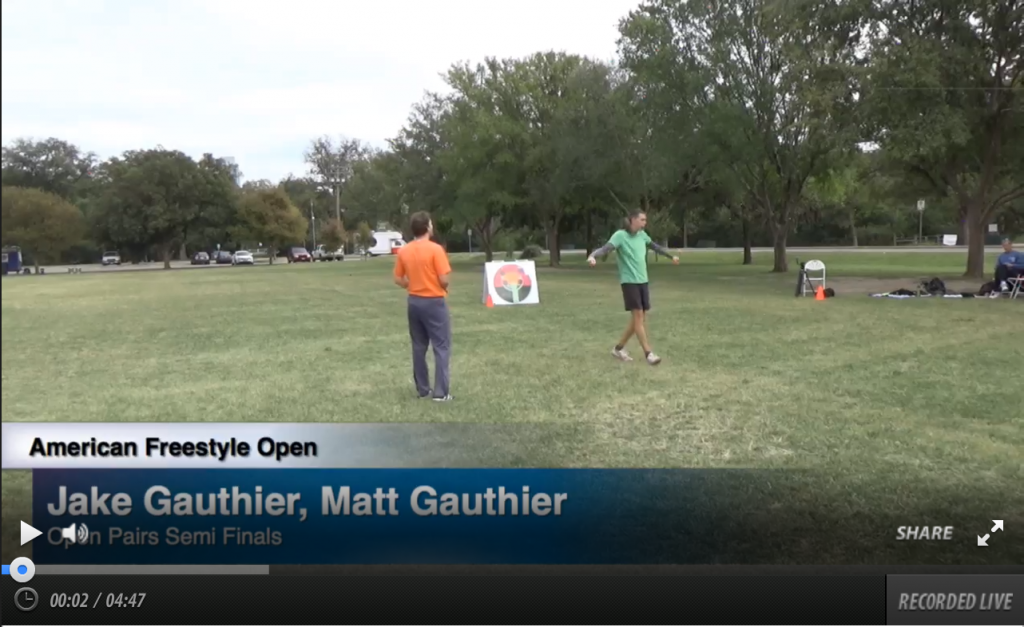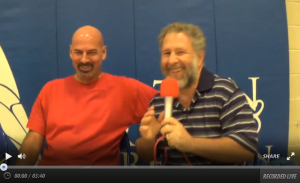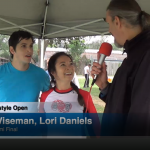Dan Yarnell was one of the top players when I started playing. He won his first FPA Worlds in 1999 with Steve Hanes. He also had a killer routine with Randy Silvey a few years later. I remember being (and still am) amazed by is unique spinning kicks and some crazy upside down passes. In this interview Dan talks about how he got started and what it takes to get to the top of the game.
Matt Gauthier explains how to do an Inverted Chest Roll
Matt Gauthier explains how to do an Inverted Chest Roll.
A Chest Roll is when the frisbee rolls from one hand, down the arm, across the chest, and out the other arm and to the other hand. A Chest Roll is performed when facing the wind so that they wind will push the disc onto the chest.
An Inverted Chest Roll is performed with the back to the wind. However, the underside of the disc is still towards the wind. Bend backwards as far as possible to provide as much surface area as possible and to get the head out of the way. Then, do a chest roll.
AFO 2014 Routines are on Youtube
All the routines have been labeled, copied from uStream to YouTube and organized into playlists.
CoOp Finals
Open Pairs Finals
Mixed Pair Finals
Womens Pairs Finals
CoOp Semi Finals
Mixed Pairs Semi Finals
Open Pairs Semi Finals Pool B
Open Pairs Semi Finals Pool A
The Chest Roll by Ryan Young
Ryan Young teaches us how to do a chest roll. A chest roll is where the frisbee rolls from one hand, down your arm, across your chest and then out onto the other arm and hand.
To practice, face the wind. Toss the disc on a steep angle so the wind will blow it back to you. Consider which direction the disc is spinning and toss it so it is close to the hand that will propel it across your chest. That is, left hand for clockwise spin and right hand for counter clockwise spin.
Next, hit the disc to give it momentum to traverse your arm, chest, arm and other hand. Try not to move your shoulders forward as the disc progresses. When the disc reaches your far hand either catch it or push upwards to propel it back in the air to try a second chest roll or other tricks.
The Scarecrow Catch
The ScareCrow is one of the more challenging trick catches in freestyle frisbee as it is blind. The position to catch a scare crow is with the arm extended straight and the thumb down. Bend over and twist at the waist so that as you twist you lose sight of the disc. Your arm swings around and you catch it just as you lose sight.
To practice, give yourself a light toss about head height over one shoulder. Toss is either flat of with a slight nose pointing behind you. Then watch the disc, bend and twist and try to find it with the hand opposite of the should you tossed the disc over.
The secret is to watch the disc as long as possible. Turn your head and your eyes toward the disc so that you lose sight only at the last possible moment.
Another tip I forgot to mention in the video is to open your hand as wide as you can. I sometimes will stretch my first finger and thumb to get the opening as wide as possible. This way there’s less chance of the disc hitting your thumb as you come around.
Nice AFO writeup by Time Warner cable
I ran across this on facebook and wanted to catalog it here. A few Time Warner news gatherers were in the gym on the last day of AFO 2014. They we taking photos, videos and interviewed quite a few of the players. The link below is the article that resulted. I love it when freestyle frisbee gets in the news. But what’s especially nice about this article is how it captures the joy of the players and invites new people into the sport. That is what Freestyle Frisbee is all about.
http://austin.twcnews.com/content/news/306176/austin-hosts-freestyle-frisbee-competition/
AFO Live Stream – Thanks for all the help
![]() I want to take a couple of minutes to say thank you to all those who helped make the live stream from AFO possible. Although I do a tremendous amount of work prior to and during the event, I could not do it on my own. So, I want to be sure the credit for spreading the jam in this way is spread around.
I want to take a couple of minutes to say thank you to all those who helped make the live stream from AFO possible. Although I do a tremendous amount of work prior to and during the event, I could not do it on my own. So, I want to be sure the credit for spreading the jam in this way is spread around.
First of all, this is the first time I have asked for funding help. The FPA awarded me a Spread the Jam Grant to help cover the cost of software. This made a huge difference in the quality of the stream I was able to produce. Thanks, Freestyle Players Association.
I also asked for help funding a new camera and other miscellaneous equipment. The money also ended up covering some of the extra data usage cost. I feel a little weird asking for money, but its just not sustainable for me to fund everything myself. I really appreciate those who pitched in: Randy Silvey, Rodney Sanchez, Berlin Jammers, Judy Robbins, Mark Davis, Paul Kenny, Boguslaw Bul, Larry Imperiale, John Titcomb, Greg Marter, and Graf Mordi.
While cost is one aspect of this project, doing the actual work is what really makes it happen. This year we had 3 cameras, a commentator, and a technical director. To make things work it took a minimum of 3 and a maximum of 5 people working together to make it happen.
Commentating was none-other-than John Houck who is one of the legends in the sport. John volunteered most of his weekend to hang out with our viewers, keeping them engaged and entertained by calling the action between rounds, telling stories, and conducting interviews. Prior to AFO, I thought that adding commentary would be something special to the live stream. But, John because of who he is, coupled with his humorous anecdotes, added more than I could have imagined.
There is a long list of people who took a turn on the camera: Tita Ugalde, Mary Zurn, Larry Imperiale, Alan Elliott, Enrique Ortiz, Lori Daniels, Lisa Hunrichs, Amy Schiller, Doug Korns, and possibly other people… as I lost track at some point. Operating the camera is one of those tasks that can boring and tedious, yet it integral to bringing a quality broadcast. I’m so pleased that so many people were willing to jump in and help. And, WoW, looking at the recordings, everyone did a great job.
Also, a special call-out to Tita Ugalde who came specifically to help with the live stream and sat at the most important camera position for all of Saturday and Sunday. The steady routine footage and view of the interviews were courtesy of Tita’s camera work.
Another big thanks goes to those who helped setup and takedown. If you haven’t seen it before, the live stream gear is a rat’s nest of wires and boxes going every which way. The first day took nearly 90 minutes to setup, with help. I know I can’t remember everyone who helped, but here are a few that stand out: Matt Gauthier, Ryan Young, James Wiseman, Enrique Ortiz, Doug Korns, John Titcomb, Gerry Geare, Rodney Sanchez, and Lori Daniels. Sorry if I am forgetting to name any other of my Rat’s Nest Assistants; it’s a whirlwind getting everything going and in the flurry of activity – every bit was very helpful.
Last, but certainly not least, I want to specifically say thanks to Doug Korns. When I was not able to act as technical director (run the computer and coordinate between all other volunteers) Doug stepped into this role. Doug also helped out at FPA 2014, so I knew what he was capable of. On Day 1, we sat together and went over the software and the process. From then on, Doug took over anytime I needed to get ready to compete. In fact, on Sunday, Doug was fully in charge in the Technical Director’s Chair. I set-up the equipment and walked away. Doug did the rest.
An important aspect to recognize about the Technical Director role is that it requires 100% focus nearly the whole time you are there: watch all cameras and choose the best camera angle to display on the stream. Between rounds, the Tech Dir is typing in players’ names (while trying to correctly spell the names), as well as choosing when to turn the camera on and off, starting and stopping the recordings of each routine, tune the audio (so the audience hears the right source), tell everyone else when to talk, where to point the camera, to stop zooming so close, etc. And, if something goes wrong, the Tech Dir has to fix it while still keeping things moving on the broadcast. This is a tough job, and Doug’s willingness to take this on shows how much he loves and wants to give back to the sport and our community. THANK YOU DOUG!
At this event I also tried to do more promotion than I have in the past. To that end, I want to thank Crazy John Brooks for his advice and encouragement and for connecting me with the PDGA. Also, thank you to Lori Daniels for similar encouragement and for making the connection to WFDF. And, thank you to the PDGA and WFDF for promoting the live stream. It’s really awesome to be a part of different disc disciplines partnering together towards our shared common goal: To play Frisbee and share our joy with the world!
AFO Live Stream – Day 3
The American Freestyle Open 2014 is now behind us. Here’s a brief review of the live stream project for the final day.
We had 400 unique viewers and peaked at 72 concurrent viewers. It seems there was more interest in the finals than other rounds as people who tuned in , stayed tuned in. However, with >600 unique views on day 1, it’s clear that the PDGA and WFDF co-promotion added to the traffic.
Operationally, things went off very well with only minor glitches that including internet becoming unstable and camera memory filling up. The main learning I came away with is that we need better coordination between the tournament MC and the live stream commentator. In the gym, the audience could tell that John Houck was speaking, but could not hear him and became frustrated that they were missing something. At some point we began doing the interviews on the MC mic so the audience could hear them.
With a total of 1231 unique views across the 3 days, I’d say the AFO stream was a success. Look for the routines and interviews to be posted on youtube soon. And, if you watched the live stream, let me know what you thoughts in the comments section.
AFO Live Stream – Day 2
![]() A quick review; 220 unique views and 35 peak concurrent viewers. Feedback has been ultra positive. People like the interviews and the “commercials” between rounds.
A quick review; 220 unique views and 35 peak concurrent viewers. Feedback has been ultra positive. People like the interviews and the “commercials” between rounds.
Today I worked at the audio levels and I think they were good. Not really any major snafus except for rain on the camera lenses. I tried pick up audience ambiance by turning on a long range microphone at low volume. I’m not sure it worked, but it certainly did not detract. And, I really enjoyed interviewing the teams after their performances. Turns out, its not as difficult as I thought to be both the technical director and the host.
Seeing the drop in unique views is a little disappointing but I imagine the the PDGA and WFDF promotion yesterday drive the extra traffic. I am thinking that future events, I should time partner announcements with finals day so that new viewers will get the best experience possible.
If you watched today, tell me how it was. The feedback helps make the broadcasts better. And, let’s brain storm on how we get more eyes on the next broadcast. Finally, tune in tomorrow. John Houck will be back as the host. And we’re sure to have shredding routined. Thanks for all your support.
AFO live Stream – Day one
 Today was the first day of Live Streaming from AFO 2014. It was alot of work, but I’d say it was successful. We had 611 unique views and peaked at 49 concurrent viewers. We also had player interviews and “commercials” (pre-recorded videos of Freestyle, including brand new learn to jam videos), and an awesome host, John Houck.
Today was the first day of Live Streaming from AFO 2014. It was alot of work, but I’d say it was successful. We had 611 unique views and peaked at 49 concurrent viewers. We also had player interviews and “commercials” (pre-recorded videos of Freestyle, including brand new learn to jam videos), and an awesome host, John Houck.
And, we had promotion from the PDGA and WFDF. Disc sports unite!
We also had a few things go wrong. For instance John’s Mic volume was to low compared to everything else so he couldn’t be heard very well. And the stream bit rate was set so high we burned through way too much bandwidth. Whoops.
But, all-in-all, I’d say a success. But I want to know what you think? Did it look good? Sound good? Good filler between the play? Please leave feedback in the comments section.
Tomorrow, we do it again.




